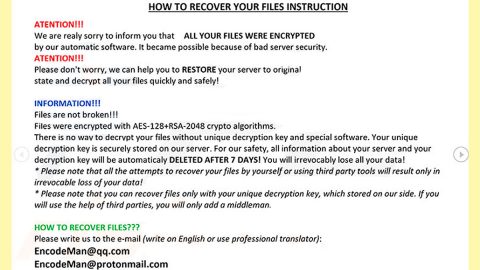What is PaySafeCard ransomware? And how does it work?
PaySafeCard Ransomware is a formidable file-encrypting threat that crashes your computer system. It encrypts your files using the AES encryption algorithm and marks them with the .rnsmwre extension and prompts users to recover their files using the PaySafeCard codes. After that, the ransomware opens its ransom note on a text file entitled @decrypt_your_files.txt that contains the following message:
“Your files are encrypted!
There is only one way to get them back: You need to send me a 20 USD PaySaveCard-Code
[Write it into the Console Window!]”
Even if the extortionist only demands a measly amount of 20 USD for the file’s recovery, that does not mean that you should go ahead and pay it. Paying the ransom won’t ensure the recovery of your files and you might end up with even more trouble than you can handle. Not to mention that it would only motivate cyber crooks to create more malware and continue their malicious activities. In other words, it’s like enabling these crooks.
Its payment method which is through PaySafeCard codes is not the usual way to process the payment since most ransomware Trojan commonly uses Bitcoins and Ukash vouchers for a while now. However, there are still other ransomware infections that use this form of payment alongside the PaySafeCard ransomware such as PAdCrypt, CainXPii or Razy.
There are three ways in which PaySafeCard ransomware is distributed to ensure the effectiveness of its attacks:
- Malicious spam email campaigns
- Malicious downloads and malvertising
- Fake software and system updates
The malicious executable file, rnsmwre.exe is distributed using those techniques in order to infiltrate your computer. To make sure that you won’t cross paths with this kind of malware, you have to be careful in opening emails especially from unknown senders and make sure that you stir clear of suspicious software installers and suspicious websites. Aside from that, an update system and antivirus would also help you avoid such infections since it strengthens your computer’s resistance against the likes of PaySafeCard ransomware.
To eliminate PaySafeCard ransomware, follow the removal instructions below.
Step 1: Open Windows Task Manager by pressing Ctrl + Shift + Esc at the same time.

Step 2: Go to the Processes tab and look for PaySafeCard ransomware’s process or any suspicious processes for that matter and then kill them.

Step 3: Open Control Panel by pressing the Windows key + R, then type in appwiz.cpl and then click OK or press Enter.

Step 4: Look for PaySafeCard Ransomware or any suspicious program and then Uninstall.

Step 5: Hold down Windows + E keys simultaneously to open File Explorer.
Step 6: Go to the directories listed below and delete everything in it. Or other directories you might have saved the bundled file related to PaySafeCard Ransomware.
- %USERPROFILE%\Downloads
- %USERPROFILE%\Desktop
- %TEMP%
Step 7: Look for @decrypt_your_files.txt and rnsmwre.exe and any malicious file that might be related to the malware.
Step 8: Right-click on it and click Delete.
Step 9: Empty the Recycle Bin.
Step 10: Recover your encrypted files.
Restoring your encrypted files using Windows’ Previous Versions feature will only be effective if the PaySafeCard Ransomware hasn’t deleted the shadow copies of your files. But still, this is one of the best and free methods there is, so it’s definitely worth a shot.
To restore the encrypted file, right-click on it and select Properties, a new window will pop-up, then proceed to Previous Versions. It will load the file’s previous version before it was modified. After it loads, select any of the previous versions displayed on the list like the one in the illustration below. And then click the Restore button.

Follow the continued advanced steps below to ensure the removal of the PaySafeCard Ransomware:
Perform a full system scan using SpyRemover Pro.
- Turn on your computer. If it’s already on, you have to reboot it.
- After that, the BIOS screen will be displayed, but if Windows pops up instead, reboot your computer and try again. Once you’re on the BIOS screen, repeat pressing F8, by doing so the Advanced Option shows up.

- To navigate the Advanced Option use the arrow keys and select Safe Mode with Networking then hit Enter.
- Windows will now load the Safe Mode with Networking.
- Press and hold both R key and Windows key.

- If done correctly, the Windows Run Box will show up.
- Type in explorer http://www.fixmypcfree.com/install/spyremoverpro
A single space must be in between explorer and http. Click OK.
8. A dialog box will be displayed by Internet Explorer. Click Run to begin downloading SpyRemover Pro. Installation will start automatically once download is done.
9. Click OK to launch SpyRemover Pro.
10.Run SpyRemover Pro and perform a full system scan.

11. After all the infections are identified, click REMOVE ALL.

12. Register SpyRemover Pro to protect your computer from future threats.












